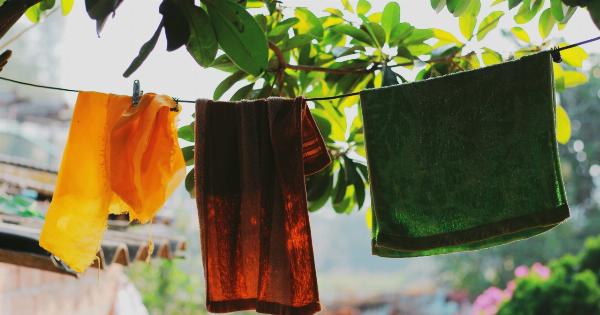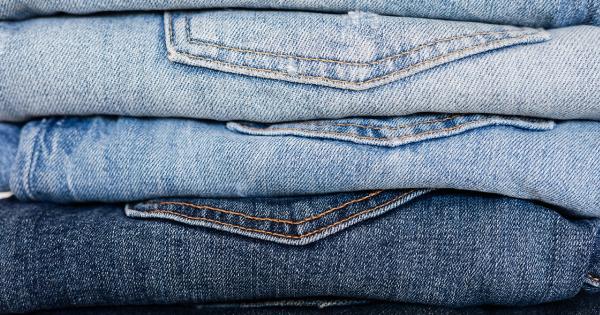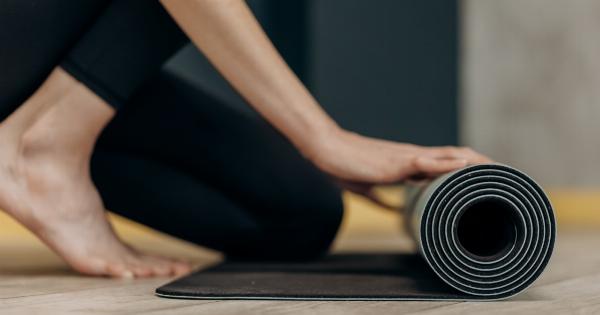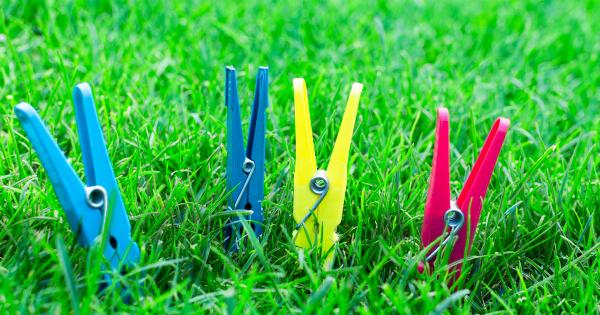Keeping our clothes clean and fresh is a necessary part of our daily routine. Washing clothes not only helps maintain good hygiene but also prevents the accumulation of dirt and stains.
However, there can be instances when our laundry doesn’t turn out as expected. There are various factors that can affect the outcome of the washing process. In this article, we will explore the 30 probable causes of common laundry woes and how to overcome them.
1. Choosing the Wrong Water Temperature
The water temperature you select plays a crucial role in the cleaning process. Using hot water for delicate fabrics can cause shrinkage, fading, or damage, while cold water may not effectively remove stains or kill germs.
Always refer to the care label on your garments for recommended water temperatures.
2. Overloading the Washing Machine
Stuffing too many clothes into the washing machine can prevent proper agitation and rinsing. This can lead to clothes not getting adequately cleaned, resulting in odors, detergent residue, or incomplete soil removal.
Follow the manufacturer’s guidelines regarding the machine’s capacity for optimal performance.
3. Insufficient Detergent
Using less detergent than necessary can lead to poor cleaning results. Clothes might appear dingy, retain odors, or have visible stains. Follow the instructions on the detergent packaging and adjust the amount based on the load size and soil level.
4. Using Too Much Detergent
On the flip side, using excessive detergent doesn’t mean cleaner clothes. It can actually result in soap residue buildup, leading to skin irritation, stiff fabrics, or musty odors. Use the recommended amount for your specific load.
5. Improper Sorting
Sorting clothes properly based on color, fabric type, and level of dirtiness is crucial. Mixing dark and light-colored items may result in color bleeding, while washing delicate fabrics with rough materials can cause snags or tears.
Separate loads into whites, darks, delicates, and heavily soiled items for optimal results.
6. Neglecting Stain Treatment
Stains should be treated before tossing garments into the machine. Ignoring stain removal can lead to permanent discoloration or unsuccessful stain removal during the wash cycle.
Pre-treat stains using appropriate techniques, such as soaking or spot cleaning, before laundering.
7. Uneven Distribution of Clothes
Properly distributing clothes inside the washing machine ensures balanced agitation and an effective cleaning process. Unevenly loaded garments may cause tangling, reduce water and detergent contact, or lead to uneven wear and tear.
Arrange clothes evenly for optimal results.
8. Using the Wrong Washing Cycle
Modern washing machines offer a variety of wash cycles designed for different fabrics and soil levels. Using the wrong cycle may result in insufficient cleaning, color fading, or damage to the clothes.
Consult the machine manual or choose appropriate cycles based on garment requirements.
9. Neglecting to Empty Pockets
Coins, tissues, and other small items left in pockets can cause damage to both the clothes and the washing machine. These items may leave behind lint, clog the drain pump, or even break internal components.
Always check and empty pockets before starting a wash.
10. Not Using Fabric Softener Correctly
Fabric softeners are excellent for improving the feel and smell of clothes, but using them incorrectly can lead to problems. Adding fabric softener directly onto clothes might cause staining, while overusing it can create a waxy buildup on fabrics.
Follow the instructions and use fabric softeners sparingly.
11. Using Harsh Chemicals
Some chemicals, like bleach or strong stain removers, can damage certain fabrics. Always check the care labels of your garments to ensure compatibility with any chemicals being used.
Using milder alternatives or seeking professional advice is recommended when dealing with sensitive fabrics.
12. Neglecting Machine Maintenance
An improperly maintained washing machine can affect the cleanliness and condition of your clothes. Mold, mildew, and dirt buildup inside the machine can transfer onto garments, leading to unpleasant odors or stains.
Follow the manufacturer’s instructions for regular machine cleaning and maintenance.
13. Overdrying Clothes
Excessive drying can cause fabrics to shrink, lose color vibrancy, or become brittle. It is essential to follow garment care labels and avoid using high heat settings for delicate items.
Hang drying or using lower heat settings can help preserve the quality of clothes.
14. Not Separating Lint Producers
Some fabrics produce more lint during washing than others. Washing lint producers, such as towels or fuzzy materials, with clothing items that attract lint can result in excessive lint accumulation on clothes.
Always separate lint producers from lint-attracting fabrics to minimize lint transfer.
15. Hard Water Problems
If you live in an area with hard water, the minerals present can affect the cleaning efficacy of detergents. Hard water can leave behind soap scum, making clothes appear dull, stiff, or discolored.
Using water softeners or adding some vinegar to the wash can help counteract the effects of hard water.
16. Using Incorrect Stain Removal Methods
Not all stains are the same, and using the wrong removal methods can set stains or worsen their appearance. Research appropriate stain removal techniques for various stains like oil, grass, or wine, and treat them accordingly before laundering.
17. Neglecting Special Care Items
Garments with special care requirements, such as delicate fabrics, beaded or embroidered items, or items with sequins need extra attention. Failure to follow the care instructions can result in damage or premature deterioration.
Hand washing or using gentle cycle settings is often recommended for such items.
18. Using an Old or Inefficient Washing Machine
An outdated or inefficient washing machine might not provide the desired cleaning power. Insufficient agitation, ineffective rinsing, or inaccurate temperature control can prevent achieving optimal cleanliness.
Consider upgrading to a newer, more efficient model for improved laundry results.
19. Incorrect Folding or Hanging
How you fold or hang clothes after washing can impact their appearance and condition. Improper folding can lead to creases or wrinkles, while hanging heavy garments improperly can stretch or misshape them.
Learn the appropriate folding and hanging techniques for different garments to maintain their integrity.
20. Not Sorting Clothes by Fabric Type
Sorting clothes solely by color is not always enough. Different fabrics have unique care requirements and may not withstand the same washing conditions. Sort clothes not only by color but also by fabric type to ensure proper care and avoid damage.
21. Using Poor-Quality Laundry Detergent
Choosing a high-quality laundry detergent can significantly impact the cleaning performance. Poor-quality detergents might not effectively remove stains or lift dirt from fabrics, resulting in lackluster results.
Invest in well-reviewed detergents for superior cleaning power.
22. Using Incorrect Dryer Settings
When using a dryer, understanding and using the proper settings is crucial. Setting excessive heat or prolonged drying times can cause shrinkage, fabric weakening, or even fire hazards.
Follow the garment care labels and adjust dryer settings accordingly.
23. Neglecting Odor Removal
Over time, clothes can develop unpleasant odors due to sweat, food, or other sources. Simply washing might not be enough to eliminate these odors.
Incorporate steps like using odor-eliminating additives, air-drying under sunlight, or airing out clothes to keep them smelling fresh.
24. Not Repairing Damaged Zippers or Buttons
Washing clothes with damaged zippers or loose buttons can cause snagging, ripping, or even tearing of delicate fabrics. Take the time to repair or replace any faulty closures before tossing the garments into the machine.
25. Frequent Overwashing
Washing clothes too frequently can lead to unnecessary wear and tear. Not all clothes require washing after each wear. Overwashing can cause color fading, fabric thinning, and reduce the lifespan of your garments.
Assess the cleanliness of clothes and avoid excessive washing when unnecessary.
26. Neglecting Special Instructions and Symbols
Care labels often contain symbols or specific instructions indicating how to handle the garment during washing. Neglecting these instructions can result in damage or dissatisfaction with the cleaning outcome.
Familiarize yourself with common care symbols and follow the guidance provided.
27. Ignoring Environmentally-Friendly Practices
In today’s world, adopting eco-friendly laundry practices is crucial. Using excessive water or energy, or choosing products with harmful chemicals can harm the environment.
Opt for eco-friendly detergents, cold water washes, and energy-efficient appliances to minimize your ecological footprint.
28. Neglecting to Check for Colorfastness
Some fabrics may bleed color during washing, ruining the appearance of other garments. It is important to test for colorfastness before including new clothes in a regular wash.
This can be done by wetting a small portion of the fabric and checking for color transfer onto a white cloth or paper towel.
29. Using Inadequate Drying Space
Cramming too many wet clothes onto a limited drying space can prevent proper airflow and prolong drying time. This can lead to the development of musty odors or mildew growth.
Ensure sufficient space for clothes to dry efficiently and rotate items for better air circulation.
30. Resorting to Harsh Scrubbing
Scrubbing clothes vigorously when removing stains or dirt can damage the fabric fibers and result in premature wear. Instead, use gentle techniques like blotting or soaking to loosen stains.
Treat clothes with care to preserve their quality and longevity.






























